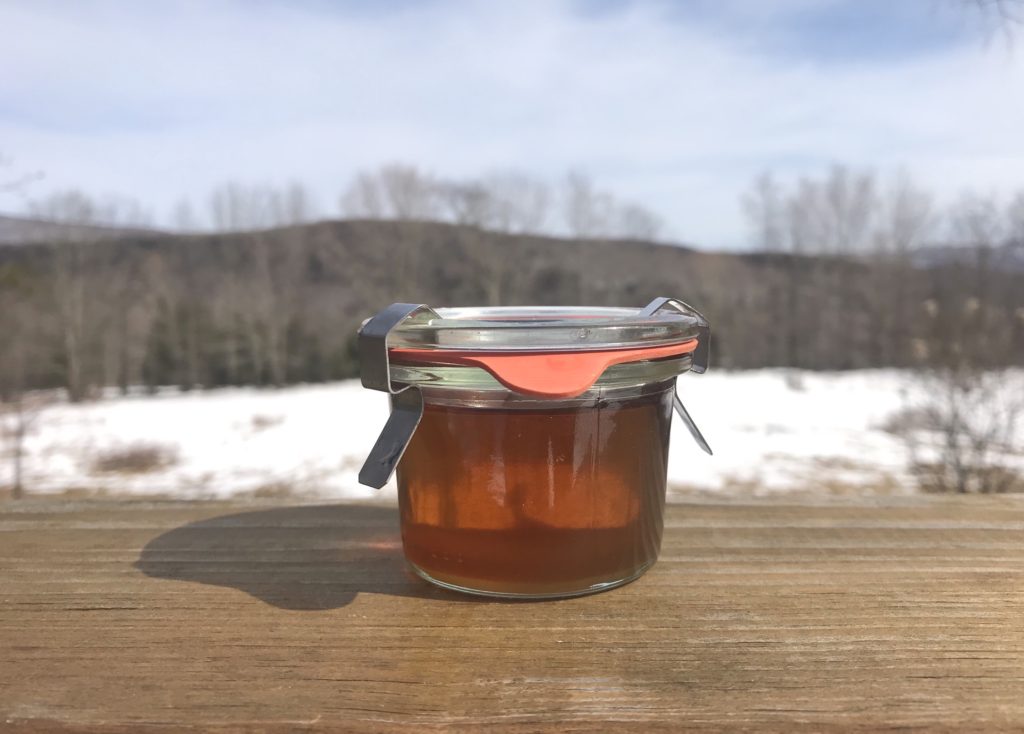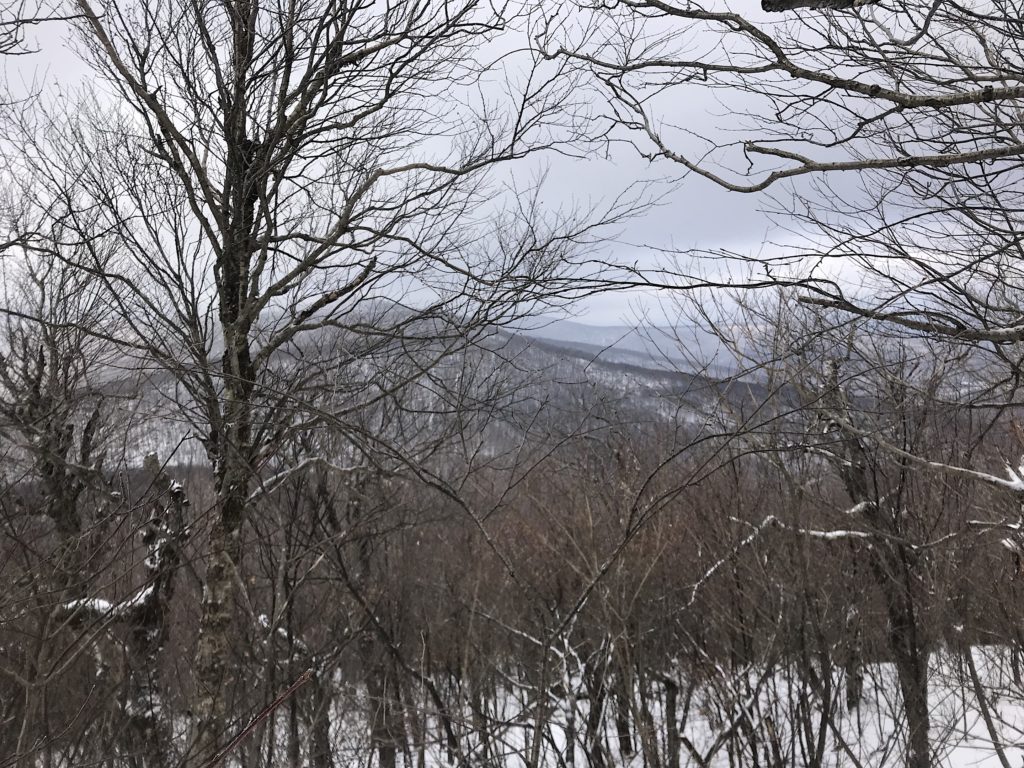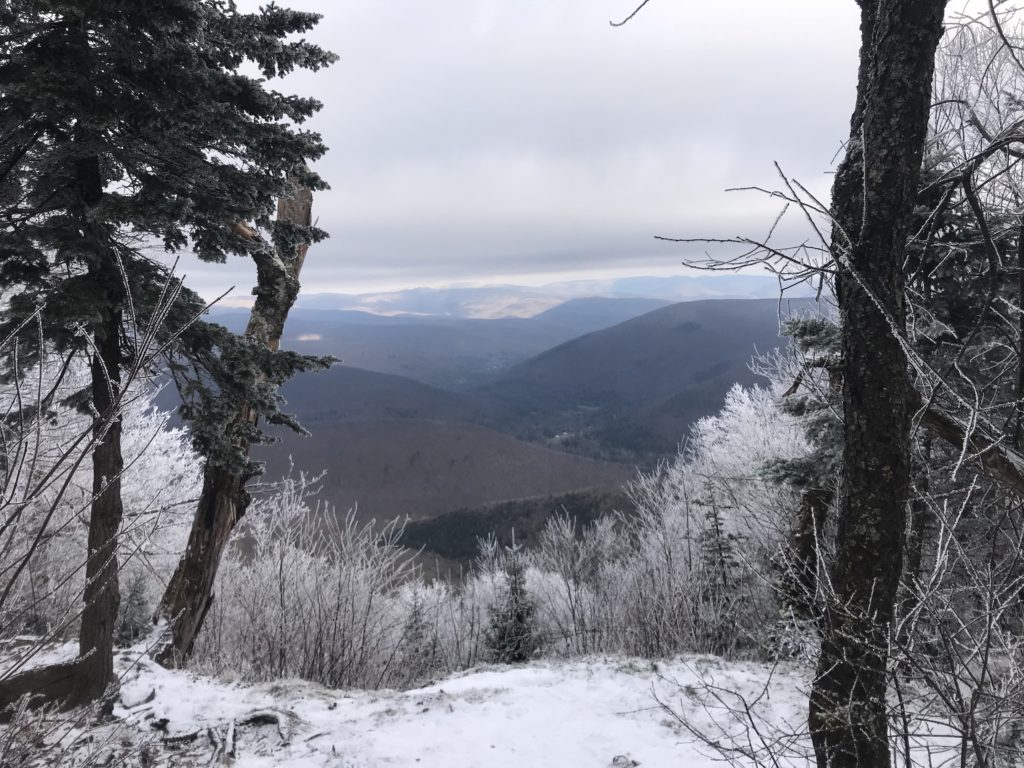A high of 47F with snow slowly receding in the sun and a veil of woolly clouds. Maple syrup season in full flow.

A high of 47F with snow slowly receding in the sun and a veil of woolly clouds. Maple syrup season in full flow.

Overcast with snow on the peaks and a brief flash of lunchtime sun through the shimmering clouds. A high of 31F.

Overcast and frigid. A high of 32F with only the lush, fir-capped peaks harboring pockets of winter wonderland at their summits. Snowmelt rushes through strong, high creeks and rivers.

80F by noon and breezeless, but cooler in the forest. A humid 84F high broken by heavy clouds, mid-afternoon showers, lightning and a long thunderstorm that dumps a mass of evening mist that rolls in and out of the valleys at dusk like a tide. Then a power cut at 8.30pm for absolutely no reason at all.
Goldenrod is a perennial that grows mostly in direct sunlight, although you can find them in partial sunlight by roadsides. You’ll usually find them in fields and on hillsides and, as the name suggests, they are tall rods (or stems) getting about two to six feet high with loose, floppy clusters of tiny, yellow flowers at the top of the stem that droop over slightly. Thin leaves, two to six inches long, grow all the way down the stem alternately, and are hairy.
We have Goldenrod in abundance – whole fields of it – so taking a few blossoms for tea is sustainable. It’s best harvested in late summer when the flowers are opening. Clip off the yellow blossoms including two or three inches of the stem. Steep three of these fresh blossoms in a cup of hot water to make a delicious fresh tea that tastes similar to a strong green tea. Sweeten with a dash of maple syrup. Don’t pour boiling water over them. Let the water cool down a little first because you don’t want to burn the flowers.
Goldenrod is said to have a number of health benefits. It soothes a sore throat, reduces pain and inflammation. It is also used for gout, joint pain (rheumatism), arthritis, as well as eczema and other skin conditions.
The flowers don’t freeze well, so if you want to save some tea for winter, make a condensed batch and freeze to dilute later with water. To make a condensed batch of tea, simply soak as much fresh goldenrod as you can fit in a mason jar of hot water. Strain through a sieve and freeze.
Like Lion’s Mane that I wrote about last year, Black Trumpet mushrooms are easy for the novice forager to identify because they don’t have any toxic look-a-likes. Plus, like Lion’s Mane they are absolutely delicious: earthy, aromatic and deeply flavorful, possibly one of the best smelling and tasting mushrooms out of all the top edibles.
To the layman, they could possibly look like, perhaps Devil’s Urn, little, round cups that grow on rotting wood but even then, the Devil’s Urn only appears in spring. Wood Ear could also be considered similar, but wood ear looks like, well, a brownish/black, flattened ear. There are black boletes, but they have pores not gills. It should be noted here that if you’re going to learn about mushrooms, a pocket guide is essential and you should have a good few year’s worth of mushroom-hunting experience before you start thinking about eating anything without at least two positive ID’s from experts. A novice should always have a mentor. Plus, most important, mushrooms affect people in different ways. Some people can’t even tolerate edible mushrooms and you may have an allergy of which you are unaware. Continue reading
Early morning sun barely breaking through thick fog. Overcast and humid with periods of break out sun, a torrential afternoon shower, and a high of 83F. The Catskills is a rain forest, consisting of a innumerable number of creeks, streams and rivers in a world that is running out of fresh water.
I discovered the American writer Linda Leaming when I read her book, Married to Bhutan in which she describes her life in Bhutan after she first went there to teach English twenty years ago. Her story was extraordinarily familiar to mine. Like Linda, I also moved to another country to work, married a foreigner and ended up making a home in an unfamiliar mountainous region – The Catskills – but Bhutan is more or less the exact opposite of America. Although what the two countries have in common is a populace that works very hard, there are so many striking differences – like their happiness despite the comparative lack of convenience. Americans are devoted to the pursuit of happiness, but the Bhutanese actually have actually achieved it. Bhutan’s secret to happiness is time plus the nurture of its environment, which comes at the expense of the aforementioned convenience. Americans can learn a lot from both the Bhutanese and the people of the Catskills (more on that later).
This podcast was taped back in 2012, one of my first interviews conducted on WIOX and the one that has received the most feedback. I hope you find it as fascinating as I do all these years later. Find her husband’s artwork here.
J.N. Urbanski
This week’s torrential rain created ideal mushroom growing conditions and the chicken mushroom, turkey tail, ghost pipe, chaga and polypores are all ripe for the foraging. Get out there and pick them, paint them or just generally admire them before they dry, rot, or get eaten by other creatures, like the hungry bears that the July drought had forced towards more urban areas. There’s even a bolete or two in advance of their normal August season. The reservoir is high, creeks are gushing and mushrooms are glowing in the understory like little alien beings. Like a movie cliche, yesterday the dog bound off into the forest to chase a much faster creature than him, and I ran off after them both and stumbled into a grove of hemlocks dotted like acne with polypore and a carpeted with ghost pipe. The polypore pictured above is a tinder polypore, good as a fire-starter for campers, was an ancient antibiotic and a sort of chewing tobacco used by certain indigenous Alaskan tribes. Continue reading
36F at 8am, snowing heavily, with the mountains shrouded in the thick fog of our profound resignation. We live in the mountains and, consequently, get all the weather. We catch all precipitation however cold it may be. The budding maple leaves that have been reddening the bare, umber brush like a light rash are covered once again in white powder for most of the day. Locals say that the weather was always like this and that back in the day, there was nothing planted before Memorial Day. Plus, of course, water is life. Keep it flowing.
44F at 10am and gloomy with mist rising off the Catskills and a light drizzle. There’s a burn ban in effect until May 15th, so the sky is keeping us well-watered and the sun decided help by completely disappearing. Wild leeks love the weather.
A high of 49F, humid, overcast with light drizzle. A spring thaw sends plumes of thick, fast-moving mist into the mountains. The Catskills becomes a steam bath. Stunning views from mountain tops. Large herds of deer graze under cover of early evening fog.
Leslie T. Sharpe, naturalist and author of “The Quarry Fox and Other Wild Critters of the Catskills” will be the guest speaker at the 5th Annual Burroughs Catskill Mountain Community Day Lecture at The Catskills Center in Arkville on April 14th at 1pm.
Her subject will be “John Burroughs and H.D. Thoreau: The Roots of American Nature Writing”.
This event has been arranged by the board of John Burroughs Woodchuck Lodge Inc, the nonprofit organization that is custodian of writer John Burroughs’ home in Roxbury.
Woodchuck Lodge was built by John’s brother in 1862, 15 years after John was born, on the east end of the Burroughs family farm. The Burroughs’ homestead where both boys grew up, later sold, is a mile away up the road and was built when John was 13 years of age. Woodchuck Lodge was John’s retreat in retirement and he is buried nearby.
After Leslie’s speech, attendees will also commemorate his birthday. Birthday cake and light refreshments will be served. All are welcome.
Saturday, April 14th 2018 1pm at the Erpf Center, 43355 Route 28, Arkville, NY 12406. (Directions in link.)
Sponsored by John Burroughs’ Woodchuck Lodge, 1633 Burroughs Memorial Road, Roxbury, NY 12474.
Friday September 2nd 9 – 9.30pm: The 3rd Annual Lighting of the Fire Towers
From a high place in the Catskills, witness the 3rd Annual Lighting of the Fire Towers when from 9 – 9.30pm, we are invited to find a place with a view of a fire tower or towers on the horizon and watch their cabin light up the night sky.
Saturday September 3rd, 10am – 3pm: Tour of the Sculpture Garden at the Catskill Interpretive Center
The Maurice D. Hinchey Catskill Interpretive Center is the gateway to the Catskill Park. Located on a 60 acre site, the Catskill Interpretive Center includes sculpture installations which are chosen by jury and displayed for a year. Come and see the 2016/2017 installation and get a tour by the artists who created the sculptures (not suitable for children under 8 years of age).